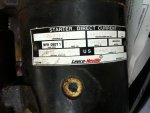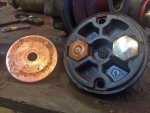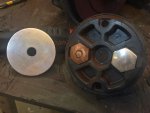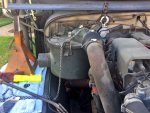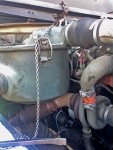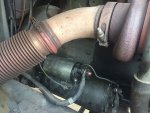I have had failures to crank since I bought my truck over six years ago; about once every fifteen tries, or so. No big deal, unless you have a half dozen veterans in the back, starting a parade!
I pulled mine today, expecting issues with the solenoid contacts. There were, but not too bad.
View attachment 736902
This is the moving disc on the back of the plunger, and the inside of the solenoid cap. The copper bolts are shorted together by the copper disc when the start pushbutton is pressed, which connects the solenoid coil to the batteries and causes the plunger to pull in. As can be seen, pitting occurs as the current arcs when the start switch is released. This causes copper to vaporize, creating pits. One of the bolts has already been filed, polished, and treated with a silver compound called "Cool Amp". No, they are not two different sizes; the angle of the camera caused a skew of the image. BE CAREFUL when you remove the bolt nuts; I was using an impact, and the nut seized to the bolt, causing it to spin which cracked the solenoid end cap.
I polished the back of the disc as well, flipping it over to use the unpitted back side.
View attachment 736903
The Cool Amp has been applied four times to the disc, and six times to the bolt. The other bolt was also reconditioned like the first (not shown). I also cut washer spacers out of .015" copper sheet and placed them behind the bolt heads to shim the bolts closer to the disc to make up for the pitting, filing, and polishing (not shown).
Cool Amp is used in high current electrical contacts in industrial environments; it is applied with a damp cloth and rubbed onto the surface vigorously. The coating on the work I did is probably a mil or so, but silver doesn't evaporate as easily as copper so these contacts will last longer (beyond my passing??).
I rigged an overhead support and a small chain hoist to position the starter; I'm getting to where I can't sling this heavy crap like I used to.
View attachment 736904 View attachment 736905
A cable choker was used around the starter.
I noticed that the turbo outlet is less than 4 inches from the starter; if you know old Chevy V-8's, you know the heat from the exhaust can cause problems.
View attachment 736906
I plan to fabricate a sheet steel (stainless?) heat shield. The starter looked fine, so did the solenoid (and I get my exhaust up to around 1,100 deg. F every time I take it to town due to a long, steep hill) but I still would like to preserve the starter.
Thanks to all you guys for the posts and info on the Leece-Neville manual!
-Ken




